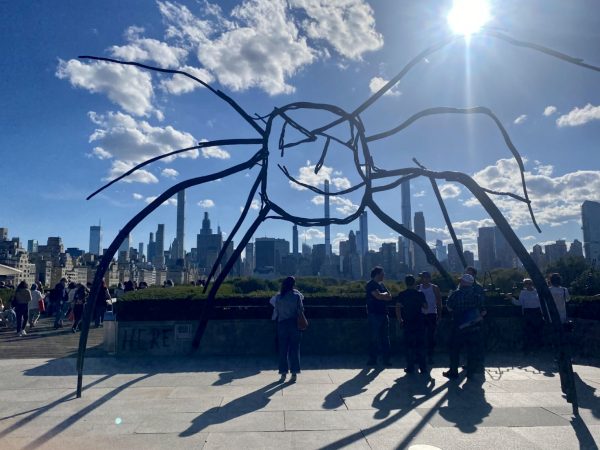Jasper Johns: Mind/Mirror Exhibition Makes its Debut at the Whitney Museum of American Art

The Whitney Museum of American Art and the Philadelphia Museum of Art are jointly showcasing over 500 pieces of Jasper Johns work. (Courtesy of Nicoleta Papavasilakis for the Fordham Ram)
On Sept. 29th, 2021, the Jasper Johns Mind/Mirror Exhibition debuted at the Whitney Museum of American Art. It is the most expansive retrospective of the famous American artist. The gallery guides visitors through over 70 years of Jasper Johns’s art with more than 250 works on display. This exhibition was intended to celebrate Jasper Johns’s 90th birthday last year, but its opening was postponed due to the COVID-19 lockdown.
The exhibition is two-fold, with the other half of Johns’s work presented at the Philadelphia Museum of Art (totaling 500 showcased pieces). Adhering to the theme of mirrors and doubles, the museum spaces are meticulously constructed to reflect one another. Each gallery presents different prints, sculptures and paintings to show the various perspectives Johns utilizes while creating his art.
Exiting the elevator on the fifth floor of the Whitney Museum, visitors’ eyes instantly meet a dizzying array of doubles. The gallery is a manifestation of the complex inner workings of Johns’s mind. Motifs of the American flag, Savarin coffee cans, maps and the human anatomy are obsessively revisited in his work.
Beyond the initial glance, visitors will notice the artworks are not identical; rather, they are distinguished by a range of mediums, color palettes and dimensions. The subtle alterations illuminate the ways in which concepts are subject to an ever-changing spectrum of Johns’s emotional states.
Jasper Johns emerged in the American art scene during the early 1950s. He became an emblematic figure of the minimalist movement, with geometry, color and repetition as essential elements of his work.
At 91-years-old, Johns continues to create poignant art that reflects the relationship between self and surroundings. The Whitney Museum features his most recent work, which was completed in 2020, during the solitary period of the coronavirus pandemic.
An oil painting titled “Slice,” illustrates a map of nearby galaxies superimposed by an anatomical diagram of the human knee. Initially, the speckled red and blue dots on a black oil abyss produce an uncanny sentiment of human insignificance in comparison to the infinitely vast universe. However, upon further inspection, the viewer can see that the particles create the faint outline of a stick figure. Simultaneously, the dissection of intricate tendons and ligaments in the knee convey the extraordinary architecture of the human body. Together, the two images depict the purposeful construction of human beings within the fabric of the universe.
“Three Flags,” is one of Jasper Johns’s most iconic paintings displayed at the Whitney Museum. As its title suggests, the work is constructed of three separate canvases depicting the American Flag. The individual paintings are layered in descending size order. The repetition creates a mind-boggling convergence of lines and stars, alternating in red, white and blue. The symbolism of “Three Flags” is still debated to this day. Some viewers interpret the painting as a romantic tribute to the nation while others perceive it to be a critique on overwhelming patriotism. Regardless, Johns wanted to present “things the mind already knows” and challenge his viewers to reexamine their connotative meanings.
Repetition also provides a visual map of Johns’s artistic methodology. He believes that his art is best conveyed in the process of creating rather than in the product itself. One room in the exhibition is strictly dedicated to Johns’ “Saverin Monotypes.” Seventeen prints with the motif of a coffee can containing weathered paint brushes occupy the space. Each print is differentiated by a unique background of handprints, crosshatches and brush strokes. Cumulatively, the double images are an expression of Johns’ artistic persona. The repurposed Savarin symbolizes how his artistic practice is interwoven into prosaic life. The interplay of color and pattern blur the lines of reality and add vivacity to the mundane.
Reflection, revisitation and refraction capture the essence of Jasper Johns’s Mind/Mirror Exhibition. His compulsive gravitations towards certain objects, along with the various approaches he utilizes to portray them dismantles the familiar. Johns compels viewers to do a double take on reality and see how it transforms with the mind’s emotional tides.
The Jasper Johns Mirrors/ Doubles Exhibition is open to the public until Feb. 13th at the Whitney Museum of American Art.

Nicoleta Papavasilakis is a senior at Fordham College at Rose Hill, majoring in journalism and minoring in Spanish. She is still quite new to the Ram,...











































































































































































































